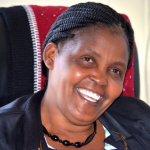Judy Wanjira Thiongo has her hands full. As the Nutrition Officer for Kandara Sub-County in Muranga County, her job involves providing nutrition services, including Vitamin A supplementation, to 24 dispensaries. Supervising the distribution of Vitamin A is, not the only thing she does, but it ranks highly in her priority list. This drives her to make sure that health facilities have adequate vitamin A (VA) stocks and the required data capture and reporting tools. “The benefits of the VA and the role it plays in giving a child an opportunity to live their dreams and life to the fullest is what motivates me to wake up early every day and go to work.”

It is not surprising that Judy has to find convictions-based motivation from deep inside. The demands of her job are huge, and they could easily make her just want to pull the blanket back over her head. This is because the cog wheels of her job run on machinery that has limited capacity, particularly personnel capacity.
“The need for Vitamin A is extremely high in Kandara,” she says. “Right now, our coverage is at 36% per cent. If you think that is very low, consider that a short while back, before the launch of the Vitamin A Supplementation Optimization Demonstration Project in Muranga, it stood at 3.4%. What we have now might not be 50% but we would rather consider our glass half full, not less than half empty.”
This project is funded by Nutrition International and implemented by Centre for Behaviour Change and Communication in partnership with Murang’a County, with the aim of improving VAS coverage among children 6-59 months in the county.
Judy says that although the need is high, the challenge she and her team face is to create demand. Children should be brought to the facilities every month until the age of 5 years for growth monitoring, immunization, and other services, however, most caregivers only bring them until immunizations are completed at one-and-a half years and then disappear. “This creates a scenario requiring defaulter tracing which the Community Health Volunteers (CHVs) have embraced and routinely give Vitamin A supplements [VAS] in Early Childhood Development and Education centres and at household level”, she says.
Why would caregivers miss out on something so important? “We hypothesize that it is lack of knowledge. We have responded by mobilizing the CHVs to disseminate knowledge at community units. At the facilities, we encourage the nurses and other healthcare workers to press home the message when they are meeting patients at the maternal and child health (MCH) clinic; we instruct them to do nutrition education including emphasizing on the benefits of VAS.”
Judy is optimistic because, as a result of the knowledge dissemination to caregivers, more children in Kandara are now being supplemented with VAS every 6 months than before. She and her team have worked hard to get here.

“It entailed a lot of sacrifice, spending long hours to analyze data, having to meet frequently with Public Health Officers [PHOs] who were coordinating the CHVs. It meant holding meetings with our healthcare workers to tell them what to do, ensuring they’re doing it the right way and that they have enough stock of Vitamin A in their facilities. It has meant they have me on speed dial and available night and day. And if they call to say they are running out of VA supplies, I move with speed to ensure that the capsules reach their facility by the time clients begin arriving in the morning. If for some logistical reason that is not possible, I arrange for them to meet me elsewhere to pick up their supplies.”
It may sound as if all Judy does is supply Vitamin A, but her duties extend much further. She is constantly reviewing the records to have as much real-time information as possible about the facilities’ stocks and to be able to anticipate their needs.
With so much to do, it comes as little surprise that one of her challenges is staff shortage. When there are enough resources, they do supervision. To do this she is accompanied by the public health nurse, the records officer, and a public health officer. “We check the registers at hand to see if the data entry is correctly done for the current month or a certain number of months. But this kind of supervision is not as frequent as it ought to be, which is every quarter. This is due to limited resources, especially personnel.”
If there were regular supervisory visits, there would be fewer mistakes at the end of the month when reports are forwarded. Lack of personnel affects work quality too. At the dispensaries, there is ordinarily one staff member (usually a nurse) doing all the services and attending to all clients (pregnant mothers, sick children, etc.) who come with any type of problem. “The nurse is overwhelmed,” Judy remarks. “When you consider that she also has more than 10 registers to fill in, you begin to understand the scale of our challenge.”
Does she foresee a future with enough health workers? Here she hesitates and then laughs. “If it was within my jurisdiction, I might answer with greater certainty. However, there is room for hope. More people employed would mean better services and less pressure on the health workers.”
Among the common mistakes, though not necessarily attached to staff shortage, was report writing. Judy explained that some facilities were giving out Vitamin A but recording it as a micro-nutrient. The data register has a column for Vitamin A, but having another for micro-nutrient caused confusion. Judy and her team have overcome this issue by discussing solutions with nurses from the various facilities as they submit their monthly reports. Such meetings have had an impact on the integrity of data and massively improved accuracy of reporting.

“For documentation we have two tools: one is the summary sheet and the other a tally sheet. The two were not matching,” says Judy. “We had numbers in the summary sheet that did not appear in the tally sheet, and tally sheet is recorded every day. It means the nurse had a heavy workload and did not remember to record.”
The team also had to improve on information dissemination. With each CHV serving about 20 households, it was a challenging task. But a little motivation went a long way in encouraging them to disseminate information in churches, chamas (self-help groups) and market places. They even wrote letters to meetings and gathering at the community level.
Hard-to-reach areas presented another challenge. “We found ourselves adding extra days to our work. During the rainy season, we scheduled the work to cover seven days but still found ourselves adding an extra 3 days to ensure we covered the number of children we needed to reach.” These efforts greatly aided the recovery of lost opportunities for children who had missed out initially.
“Demand creation is of utmost importance, therefore we have purposed to give caregivers correct information which includes the benefits of VAS to their children and the need to have the children supplemented twice yearly, every 6 months, until they are 5 years of age.”
It is a heavy task on the shoulders of Judy and her team, but she reckons that it is a worthwhile price to pay to better the future of the children of Kandara. She concludes “The small act, of issuing Vitamin A helps the child race to the future better secured to succeed in it.”



